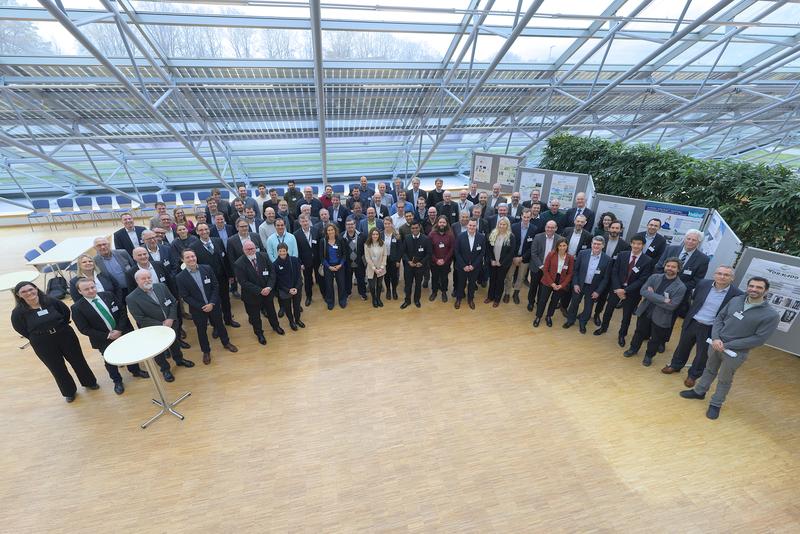Clean Sky 2 "MFFD": Ready for robots – Welding thermoplastic aircraft fuselage structures
Successful "MFFD" stakeholder event in Stade with groundbreaking results for the automated assembly of thermoplastic aircraft fuselage structures
On November 28, 2023, a stakeholder event with around 100 participants took place in the context of the "Multi Functional Fuselage Demonstrator" ("MFFD") at the Fraunhofer Institute for Manufacturing Technology and Advanced Materials IFAM in the Research Center CFK NORD in Stade, Germany. With the participation of the European project partners, a comprehensive overview of the current status of the demonstrator was provided. Particular attention was paid to the advanced assembly process using thermoplastic welding techniques as well as the presentation of the pre-integrated thermoplastic upper and lower shells.
The "MFFD" is a research platform with the aim of practically testing the technologies developed by all partners involved as part of the EU-funded Clean Sky 2 project "Large Passenger Aircraft" on a 1:1 scale. The event focused in particular on the automated assembly process using thermoplastic welding processes, which is unique in this size range, as well as the presentation of the pre-integrated thermoplastic upper and lower shells that have already been completed.
A key element of the stakeholder event was the presentation of automated assembly processes for thermoplastic welding of the longitudinal joints on the fuselage. The project partners impressively demonstrated how these innovative technologies not only increase the efficiency of production, but also improve the structural integrity of the aircraft. This progress marks a significant milestone towards future aircraft construction methods, aircraft production technologies, and aircraft materials.
Another highlight of the event were the thermoplastic fuselage half shells of the "MFFD", which were made available as equipped modules. These were particularly convincing due to the high degree of pre-integration, the significant reduction in the number of rivets used and the resulting weight reduction. On the one hand, the automated pre-integration opens up a high increase in efficiency with a view to high-rate production in civil aviation, because all components no longer have to be brought into the closed fuselage and assembled there as before; on the other hand, the weight reduction achieved is decisive for the fuel efficiency of aircraft.
The aim of the event was not only to present results, but also to provide a platform for intensive exchange between stakeholders, including aviation companies, research institutions, technology partners, and funding bodies. The discussions enhanced understanding of the challenges as well as opportunities in the field of thermoplastic aircraft structures and established the foundation for future collaborations.
The organizers are very satisfied with the high level of participation and interest of the participants. The progress shown underlines the relevance and potential of these pioneering technologies for the future of the aviation industry.
Project partners involved in the "MFFD":
• Acroflight Ltd, Witham, UK
• Aernnova Aerospace S.A., Spain
• Aeromechs srl, Aversa, Italy
• AIMEN – Asociación de Investigación Metalúrgica del Noroeste, O Porriño, Spain
• Airbus
• Aitiip Centro Tecnológico, Zaragoza, Spain
• ALPEX Technologies GmbH, Mils, Austria
• BCC – Brunel Composites Centre, University London, UK
• CETMA – Centro di Ricerche Europeo di Technologie, Design e Materiali, Brindisi, Italy
• CT Engineering Group – Ct Ingenieros Aeronauticos de Automocion e Industriales Slu, Madrid, Spain
• CTI Systems, Lentzweiler, Luxembourg
• Delft University of Technolgy, Delft, Netherlands
• Diehl Aviation Laupheim GmbH, Laupheim, Germany
• Diehl Comfort Modules GmbH, Hamburg, Germany
• DLR – German Aerospace Center, Center of Lightweight Production Technology Augsburg, Germany
• DLR – German Aerospace Center, Center of Lightweight Production Technology Stade, Germany
• Element Materials Technology, Sevilla, Spain
• FADA – Andalusian Foundation for Aerospace Development / CATEC – Center for Advanced Aerospace Technologies, Sevilla, Spain
• FFT Produktionssysteme GmbH & Co. KG, Fulda, Germany
• Fraunhofer-Gesellschaft, Fraunhofer Institute for Chemical Technology ICT,Pfinztal, Germany
• Fraunhofer-Gesellschaft, Fraunhofer Institute for Manufacturing Technology and Advanced Materials IFAM, Stade, Germany
• Fraunhofer-Gesellschaft, Fraunhofer Institute for Casting, Composite and Processing Technology IGCV, Augsburg, Germany
• Fraunhofer-Gesellschaft, Fraunhofer Institute for Material and Beam Technology IWS, Dresden, Germany
• GKN Aerospace, Fokker Aerostructures BV, Papendrecht, Netherlands
• GKN Aerospace, Fokker ELMO BV, Hoogerheide, Netherlands
• HSLU – Lucerne University of Applied Sciences and Arts, Luzern, Switzerland
• KVE Composites Group, The Hague, Netherlands
• LSBU – London South Bank University, London, UK
• NLR – Royal Netherlands Aerospace Centre, Marknesse, Netherlands
• Ostseestaal GmbH & Co KG, Stralsund, Germany
• Premium AEROTEC, Augsburg, Germany
• Rescoll, Pessac Cedex, France
• SAAB AB, Stockholm, Sweden
• SAM XL, Delft, Netherlands
• Techni-Modul Engineering, Coudes, France
• Technical University of Munich, Chair of Carbon Composites, Munich, Germany
• TWI – The Welding Institute, Cambridge, UK
• UPAT – University of Patras, Patras, Greece
• XELIS GmbH, Herford, Germany
Weitere Informationen:
https://s.fhg.de/iG5
https://s.fhg.de/CleanSky2MFFD
Die semantisch ähnlichsten Pressemitteilungen im idw



